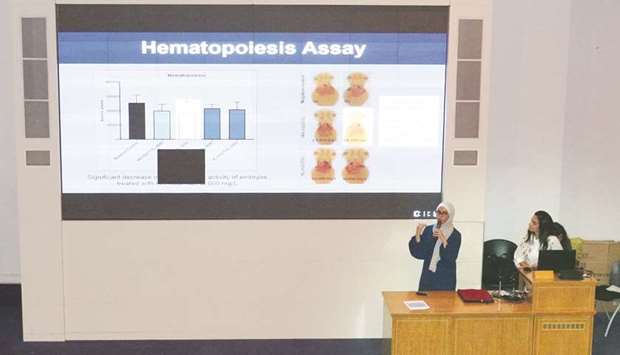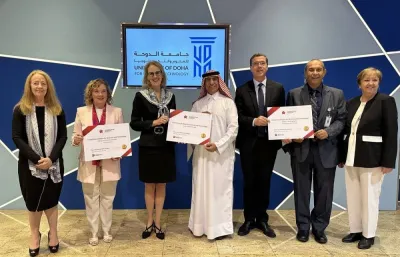A group of 18 biomedical science students of Qatar University presented their graduation projects recently covering various subjects with the majority tackling diseases frequently encountered in the country.
Sara Jemmieh and Amira Kohil presented their research project entitled, “Epidemiological Surveillance and Molecular Epidemiology of Viral Meningitis in Qatar”.
The project, developed under the supervision of Prof Asmaa al-Thani and Dr Hady Yassin, showed that among 2,261 patients suspected to have meningitis during the period of September 2018 – September 2019, only 7.8% were diagnosed with viral meningitis with higher prevalence in males.
Based on the molecular analysis done in the biomedical research centre, the most common viruses circulating in Qatar were Echovirus-3, Echovirus-11 and EV-C105. This study, first of its kind in Middle East and North Africa region, highlighted a strain that is associated with non-polio paralysis.
Moneera Nasir and Hissa al-Thani used a chick model embryo to investigate the effect of hyperglycaemia on embryonic heart development. They found that hyperglycaemia affected the blood flow velocity and ejection throughout the developing heart. It altered the gene expression and changed grossly the heart structure. This study, supervised by Dr Marwan Abu-Madi and Dr Hussin Yalsin, aimed to develop a chick model of hyperglycaemia to investigate congenital heart defects in babies of diabetic
mothers.
On the molecular genetic field, two projects utilised data from Qatar Genome Projects supervised by Dr Mashael al-Shafi. The first study underpin glucose-6-phosphate deficiency in Qatar and was done by Shaza Malik and Roan Zaid, while the second project was conducted by Samia Ahmed and Mariam Radi shed the light on some novel mutations that are believed to correlate with the pathogenicity of malignant hyperthermia in Qatar.
Another two projects supervised by Dr Hatem Zaid had the recognition of being published in scientific journals. Hend Eldous and Zainab Mahgoub studied a collection of missness mutations in GBA gene that is known to predispose patients with Gaucher’s disease to develop Parkinson’s disease. In this study, the most deleterious mutations shared between the two genes were identified and proteins such as GBA2, GLB1 and GALC, which interact with the GBA protein, were mapped. The second project was done by Maryam Niazullah and Sadia Tasneem to study the effectiveness of using computational tools in variants classification of patients with Pomp disease. Both projects may serve as a platform for potential development of therapeutic drugs.
Nahjeha Rizwan and Waad Elkhair under the supervision of Dr Ibrahim Mustafa studied the effect of macromolecular iron chelator (Deferoxamine covalently attached to a starch backbone) on platelets aiming to find a manner to reduce the toxicity of iron chelators used in the thalassaemia therapy. Sara Abdelghaney and Somaia Abouzaid studied the sero-prevelance of Hepatitis E virus and compared between the detection methods of HEV antibodies using non-A-C- hepatitis samples of patients in Qatar, while Hoda Najjar and Farah Alserr studied the toxicity effect of semiconductor photocatalyst compounds (HH-rGO/TiO2 and H2-rGO/TiO2) on zebrafish. They found that HH-rGO/TiO2 compound has more severe toxic effect at high concentration than H2-rGO/TiO2 did. The last two projects were supervised by Dr Gheyath Nasrallah.

A student presenting her project.


